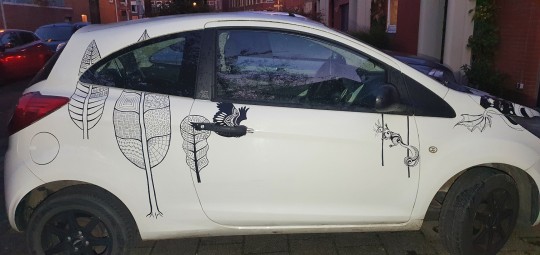All my artsy things. My main blog is here: https://drosera-sundews.tumblr.com/
Don't wanna be here? Send us removal request.
Text


One day someone is going to use an AI to generate a peaceful meadow landscape and one of these creepy people (or distorted parts of them) is going to be in there and I think that is beautiful.
Down with art AI
14 notes
·
View notes
Text
On AI and art theft

This one’s for you @drawsoneverything
So starting off with a disclaimer. I do not know how deviantart’s Dreamup works. I never worked there. I just know how AI works in general.
Shortest version: AIs (or neural networks, which I assume Dreamup is) are programs that mimic human neuron cells -and thus human learning processes-to a degree. A big difference between a neural network and a regular computer program is that neural networks require training. Like a human would require learning.
A neural network (the simple ones, at least) consist of a few ‘layers’ which contain many ‘nodes’. At least 3 are required, an input and output layer, plus one extra layer in between. Imagine it as something like this:
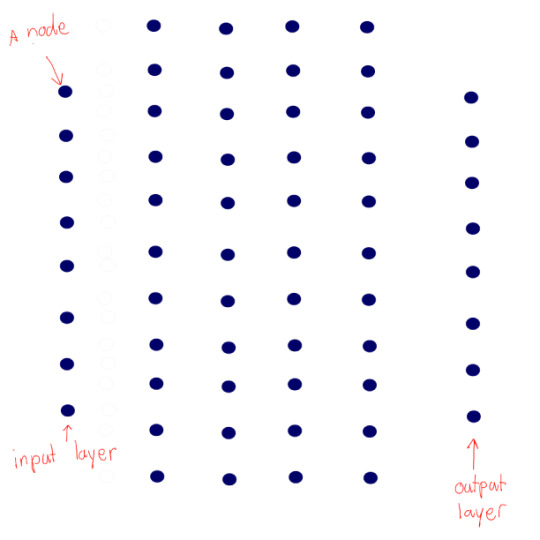
Naturally, this will all be computer code. But this is the basic anatomy of your simplest neural networks.
Each node is connected to each node, like so:

Not gonna draw all of it but you get the gist, ey. They are all connected much like -once again- neurons in the brain.
Now once you make an empty neural network like this it can’t do anything. It’s there but it’s useless and it’s interchangeable with every other untrained neural network (barring amount of layers and numbers of nodes).
What’s next is thinking of the task you want your network to perform. For example, to train it to recognize hand written letters. In this case, you’d have 26 nodes in your output layer, one for each letter of the alphabet.
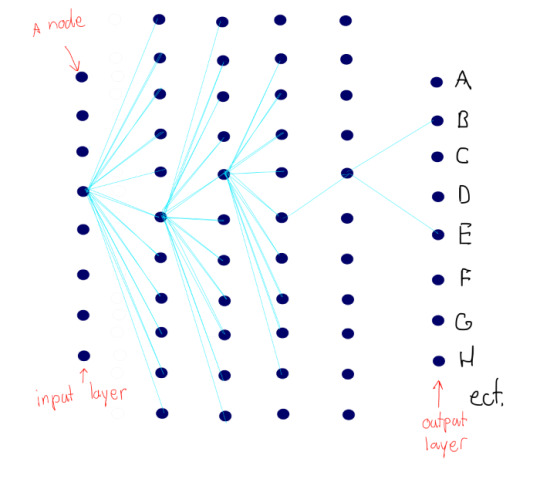
Now we need some training data

Perfect. Now imagine that’s a dataset with 5000 people’s handwriting. You need quite a lot of data to properly train an AI.
The idea is we want to input an image of a letter in any handwriting, and we want the AI to fire one of it’s output neurons, namely the one corresponding to the letter it ‘sees’.
The images need to be translated to numerical values, in order to be put in the input layer. This can be done, for example, by translating each pixel of the image in a numerical value, and having each node in the input layer be a ‘pixel’. In a human, these would be the neurons in our retina, or the back of your eye.
Translation of the image is going to look somewhat like this:
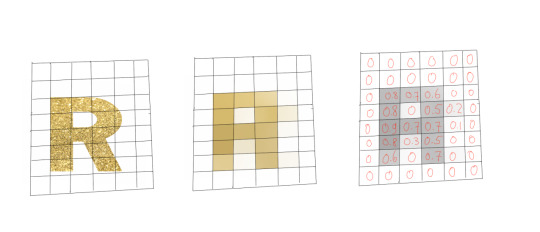
With the red numbers going into the input layer as the starting values.
We can now input our images. Something complex is going to happen. Every node is going to look at the values of the input nodes and nodes before them, and gain a value based on that, following arbitrary, random patterns. You don’t need to know the specifics here, just know that now that we have input, the nodes (or neurons) can fire.


Wow, the AI is just super wrong.
That’s okay tho, we can simply run it again until it hits the right answer by chance.
This is what the training is for. You need a dataset that’s annotated. In this case a human has to look at the inputs and identify them, so they can tell the AI if it’s right or wrong. If you do this enough times, the AI will learn to do it on it’s own.
And now here’s the catch. With every new piece of input data the machine guesses right, the values Thiof the nodes in the middle layers are changed. Like a maze, the paths to the right exit become clearer with every time the maze is completed. And while the values of the in and output layers are changed with every run, the middle layers remain. This is where the learning happens.
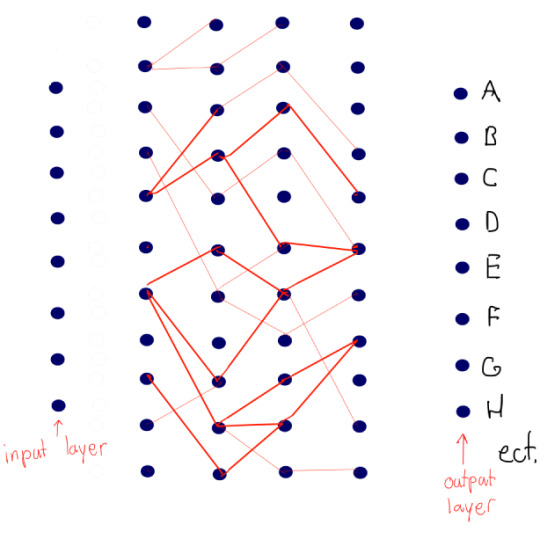
This is a trained neural network. And this is why it doesn’t matter that deviantart changed their policy to opt-in instead of opt-out. Those few days were enough. Once you train a neural network it doesn’t need it’s training data anymore.
Worst thing is, the middle layers are very much a black box. We don’t know what happens in there. The AI learns to categorize things on learned criteria, but what those are we can not know.
This is a very shortened down version of a very complex process ofc. Naturally, an art generator like DreamUp is going to be much more sophisticated. But I recon it follows the same rules as the simpler neural networks, which gives us something to work with.
Once a neural network is trained it cannot be ‘untrained’. Once you taint the dataset it’s very hard to reverse the effects. And generally, you can keep training an AI to make it better even if it’s already in use. Which I’m guessing is what deviantart is still doing with any new artworks that are added without the noai-tag
And the art on deviantart is already a neatly annotated dataset. We (the artists) have been annotating it by putting descriptions below the artworks, and giving it titles describing what the work depicts.
And oh, wouldn’t it be such a shame if someone were to accidentally add wrongly annotated art to this young, impressionable AI’s dataset.


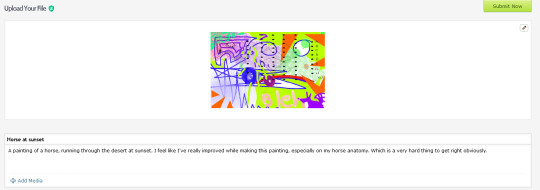
Oh wow, if you uncheck the noai checkbox and then go back to re-edit your deviation, deviantart even let’s you directly annotate your art for their database! How convenient!

No artist alive has ever been able to draw a proper horse, I’m going to make sure this AI imitates life. Maybe in my next work I will teach it how to draw ‘the other eye’.
This is the beauty of the system. The AI can learn all it wants, but in the end it’s not a person. It doesn’t understand what it’s looking at.
Thus, we can do the most human thing possible to this mindless piece of code, lie!
This is the toddler we can learn curse words. This tool was designed to steal art en-masse, but it was left hilariously open and vulnerable. Let’s break this stupid thing!
Honestly, they called it deviantart, if anything I’m living up to the name.
#posting from main to my art account for once#i try to keep this art-only but this is an exception#its very important to not just me but all onlibe artists#antai#ai art discourse
149 notes
·
View notes
Photo

Today I taught deviantart’s DreamUp AI how to draw a horse. This is clearly a horse, can’t you tell?
Want to know more about neural networks, how to counter them and what I’m doing with all this antAI art? I explain it here.
3 notes
·
View notes
Text
More antAI art. I’ll say it again, once an AI is trained it doesn’t need its training dataset anymore. Our art was stolen and there’s no way to get it back. There is however a way we can make stunts like this more difficult for anyone in the future.

The solution is not to be silent, it’s to be loud. Make garbage art and corrupt the input data with everything you’ve got!
21 notes
·
View notes
Text
Hey y’all new art style just dropped. It’s called AntAI art. The idea is you purposefully make something as ugly as humanly possible and then post it to deviantart with the “authorized for inclusion in third-party AI datasets” checkbox marked.
Look at this masterpiece

I hope deviantart’s AI learns from this
26 notes
·
View notes
Photo

And as a spectacular end to a month full of art, a collab with @daydreams-stream! His pixel art ft. my newly acquired vector art skills.
9 notes
·
View notes
Photo

1 note
·
View note
Photo

Joke’s on you, I never got out of my dinosaur phase
9 notes
·
View notes
Text

I think my favourite thing about vector art is how everything is completely reusable
13 notes
·
View notes
Photo
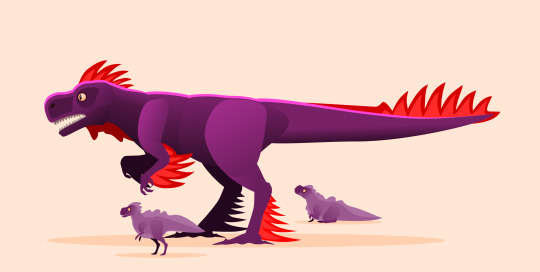
Remake of an older work, now with colours!
9 notes
·
View notes
Photo

1 note
·
View note
Photo
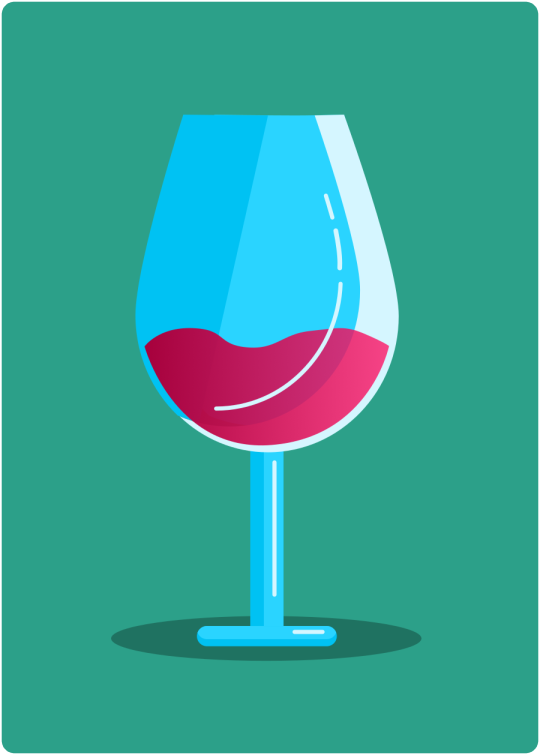
1 note
·
View note
Text
Here we go again!



10 notes
·
View notes
Photo

lil fox
11 notes
·
View notes

